How To Replace Wooden Fascia Boards With Upvc
UPVC Fascia, Soffit and Bargeboards
When putting up new fascias, soffits and bargeboards or replacing them, one choice is to fit UPVC. Ordinarily available in white, UPVC fascia and soffit material volition relieve maintenance and looks great - there will be no need for repainting every other year, simply wiping down with a damp cloth should bring information technology back.
On some houses, the existing fascia will include fixings for the telephone and/or mains electricity, these services will need relocating onto any new UPVC fascia you fit, this relocation MUST to undertaken by the advisable service supplier, then speak with them earlier you offset.
Although not cover by this page, the roof guttering will demand to be removed before the fascia can be replaced.
Safety!!
Retrieve that replacing fascia, soffit or bargeboard necessitates working at height and due care is necessary. It is not a job for a person on a ladder. Appropriate scaffolding is highly recommended.
When replacing a wooden fascia, soffit or bargeboard, information technology is recommended that the old fascia, soffit or bargeboards are all removed. Some 'professionals' will clad over existing wood simply this risks trapping moisture which could crusade serious rot in the construction.
Different types of board
 Annotation that different styles of board are available:
Annotation that different styles of board are available:
- Cover Board
- Fascia Board
Cover Board is, every bit the proper noun suggests, for covering existing fascia, whereas Fascia Board is intended for use without a bankroll surface. While Cover Board tends to be thinner as it is not acting solitary every bit role of the construction, the master difference is that Fascia Board has a recess along the inner corner to locate the Soffit whereas the inner corner of Cover Board is a plain right-angle.
Fascias and Soffits
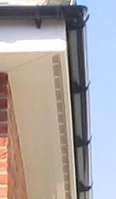 Current edifice regulations require ventilation in the soffit for new buildings (equivalent to a ane inch gap along the whole perimeter), although non absolutely necessary, when plumbing equipment replacement soffit, it is worth considering fitting ventilated soffit to improve ventilation of the roof void.
Current edifice regulations require ventilation in the soffit for new buildings (equivalent to a ane inch gap along the whole perimeter), although non absolutely necessary, when plumbing equipment replacement soffit, it is worth considering fitting ventilated soffit to improve ventilation of the roof void.
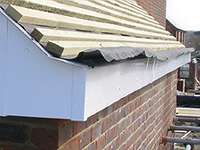 If y'all demand to supplant wooden fascia, this probably indicates that the edifice is 20 years or more than quondam and, where fitted, the covering felt nether the tiles should be checked at the eaves. Felt often deteriorates at this point and, if necessary, information technology should be replaced up to the first batten (or, equally a minimum, 12 inches (300 mm)). When fitting new felt, ensure that information technology projects nigh iii inches (75 mm) over the fascia and is fitted nether the existing felt so that any water runoff runs onto the new felt rather than nether it.
If y'all demand to supplant wooden fascia, this probably indicates that the edifice is 20 years or more than quondam and, where fitted, the covering felt nether the tiles should be checked at the eaves. Felt often deteriorates at this point and, if necessary, information technology should be replaced up to the first batten (or, equally a minimum, 12 inches (300 mm)). When fitting new felt, ensure that information technology projects nigh iii inches (75 mm) over the fascia and is fitted nether the existing felt so that any water runoff runs onto the new felt rather than nether it.
Points to remember:

- Let 5 mm clearance at each end of the material to let for expansion.
- Fit a cover strip at each joint and corner.
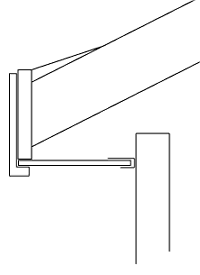 The effigy to the correct shows an existing wooden fascia clad with UPVC, if y'all make up one's mind to utilise this method, it is best to remove the existing soffit. As most existing soffits fit into a slot on the within of the fascia, it is possible to release the soffit by cutting off the bottom of the fascia.
The effigy to the correct shows an existing wooden fascia clad with UPVC, if y'all make up one's mind to utilise this method, it is best to remove the existing soffit. As most existing soffits fit into a slot on the within of the fascia, it is possible to release the soffit by cutting off the bottom of the fascia.
The new fascia should be pushed up under the ends of the tiles and levelled before fixing, it'southward easier to get the fascia straight if the lowest row of tiles tin be pushed up out of the manner while the fascia is positioned and stock-still. Gear up the fascia using plastic headed stainless steel ring nails (specifically supplied for the job), two vertically at 600 mm horizontal centres. Position the nails vertically so that they spread the load, ane near the summit of the surface behind, one nigh the bottom. Go along the vertical position of the nails constant between horizontal positions otherwise the line of nails will look a mess.
The building side of the replacement soffit can be fixed (see beneath):
- Into a upvc channel fixed to the wall of the firm.
- Screwed to a wooden batten fixed above the soffit to the wall of the house.
- To the top of the outer brickwork using either a batten down from the rafters or a structural glue betwixt the soffit and the top of the wall.
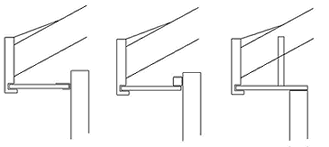
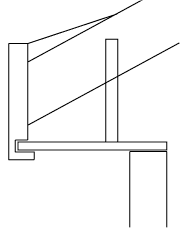 As mentioned above, to do the task properly, the original timber fascia, soffit and bargeboard should be removed before plumbing equipment replacements.
As mentioned above, to do the task properly, the original timber fascia, soffit and bargeboard should be removed before plumbing equipment replacements.
Any rot in the ends of the rafter should exist repaired using skilful quality timber treated with preservative.
Make sure that any old nails in the ends of the rafters are removed (or knocked in below the surface).
The eaves felt should be checked and repaired.
Fix the fascia to the ends of the rafters using plastic headed stainless steel band nails, with the first set of tiles pushed up, locating the ends of the rafters is easier.
Bargeboard
Cladding Bargeboards with UPVC is similar to cladding fascias, the chief divergence is that some cutting of canvas UPVC will exist necessary to shape effectually the eaves stop.
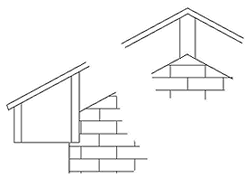
Typical eaves end and bargeboard on gable stop

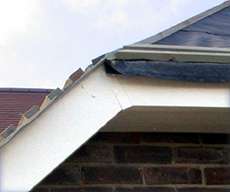
Eaves end and bargeboard on part-hipped roof
Source: https://www.diydata.com/projects/fascia/fascias_soffits.php

0 Response to "How To Replace Wooden Fascia Boards With Upvc"
Post a Comment